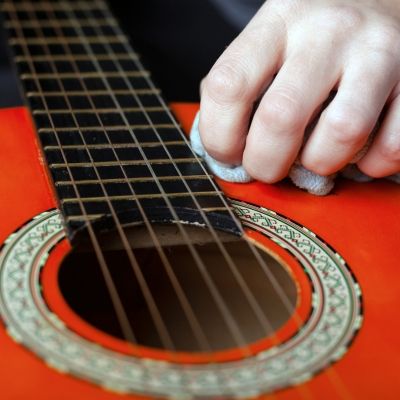Guitar Maintenance: How To

This article was written by Shawn Leonhardt from Guitar Tricks and 30 Day Singer!
There are certain steps to take to make sure your guitar stays in great shape; some are simple, while others can take a little more research. The best step of all is to be proactive and prevent problems before they occur. Here are some tips, tricks, and how-to’s for guitar maintenance.
Get a Proper Guitar!
This is an often-overlooked step. A cheap guitar will be hard to set up to keep it working correctly. Don’t start your guitar lessons off on the wrong foot with a cheap guitar. You’ll need a somewhat decent instrument in order to learn how to play. If the intonation is off or the neck is not curved right, you will struggle to play. Even a professional guitarist cannot play on an instrument that doesn’t have a proper build. A guitar doesn’t have to be super expensive, but too cheap is too good to be true!
Basic Tools and Gear
- Soap and washed hands before you play will save a lot of trouble
- Cloth for wiping the guitar down
- Screwdrivers and pliers for intonation and string fixes
- Cleaners and polishes for the right kinds of wood
- String gauge tools for measuring height
- New strings for replacement
- Tuners in case a phone app doesn’t work
- Lubrication for the tuners and nut is occasionally required
- Luthier tools if you plan on doing more intense work
- Electronic set tools like soldering irons if you want to change pickups
Basic Preventative Measures
Preventative measures are the best way to keep the guitar in good working order. It’s always best to prevent problems as, once you have them, they may not be fixeable!
Keep It Clean
Fretboard and string cleaning should be done every time to keep gunk and oil off the boards. If this is done often, you do not need to use cleaners that much. Polish and cleaners should be used sparingly as the wood and finish can be damaged by the wrong products; sometimes, a moist cloth works fine. Also, be sure to clean the headstock, bridge, and keep everything clear of dust and particles.
If you have a neglected or second-hand guitar, you may need to do a much deeper cleaning. In that case, better chemical cleaners and some light brushes or scrapers may be needed to get really ingrained gunk out. If possible, try to avoid getting to this point as too much dirt on the strings or frets will affect the sound!
Keep It In a Case
Watch the temperature and humidity; if not kept in a case, the wood and neck will warp over time. If you like to hang guitars on the wall, beware that they may one day catastrophically break! It happens especially during humid summers and dry winters. Good solid cases can be expensive, but they will make your guitar last longer. And usually, with time, the sound of the guitar ages and gets better, so take care of it!
Use Proper and Clean Strings
Strings are the life of the instrument - that is where the sound vibrations originate! Experiment with strings and see which work best, find the gauges that fit with your model, and try different materials out. Wipe them down after use and keep them in tune, as strings may be the most important part of maintenance!
One way to know that you have a good guitar and are practicing proper maintenance is that the guitar will stay in tune over long periods in a proper case. If you play it after some time where it has been stored and it is very out of tune, you need to check the tuners, neck relief, and for other potential issues.

More Complicated Maintenance
These are steps of guitar care that go beyond the general beginner concepts. In most cases, you want someone experienced, but it’s also fun to learn. Just don’t start learning on an expensive guitar; find second-hand gear to practice with!
Truss Rods
The truss rod allows you to adjust tension on the neck to fix the curve with the strings. The neck needs some relief so chords in the middle don’t hit the frets. But too much makes the strings very high and then the action is bad. Generally, truss rods are left to experienced luthiers but many try it on their own.
If you insist, get a set of measuring tools to see the gauge and relief. Turn the truss rod clockwise to fix the “up bow” and counterclockwise to fix “back bow.” Do not force it if it won’t move, and most of all, make small movements and let it sit overnight, as adjustments aren’t instant. You don’t need to approach the truss rod in fear, but some common sense and careful movements are important!
Pickups and Electronic Parts
Changing the pickups out in a lower-quality guitar is a right of passage for many guitar lovers. The inner workings of an electric guitar are usually not that complicated, and with the help of tutorials, you can make big changes. If you practice enough, you can even make your own Franken Guitar, pieced together like the monster itself!
As far as cleaning goes, deoxit spray and other electronic cleaners are great for getting muck and rust out of potentiometers, jacks, and wires, but they can also gunk up the insides. If your electronic equipment and parts are that scratchy, it may be best to just replace them. In some cases, you can even add new parts and switches, experiment! Some people add circuit-bent devices for noise music. It’s up to you how far you want to go.
Proper Setup
An acoustic guitar is not easy to change the intonation, but an electric guitar can be fine-tuned. It is helpful to learn the notes and repair of the guitar to know how to adjust the intonation. Take notice of the first time you play a guitar that it is set up right, and always use that as a future guide. Again, take it slow and make small adjustments and see how the intonation changes.
A capo on the first fret and holding down the 12th will give a good measurement of the length between the strings and fretboard, or the action of the guitar. By adjusting the bridge, we can change the action, and you can use this measurement to know which way the truss rod may need to be turned. But we don’t generally fix action with the truss rod; use that mainly for neck relief.
Troubleshooting
Buzzes, dead points, bad intonation, and weird sounds will come from your guitar! Sometime, the nut is too high and that causes the first few barres to sound off. Other times, the nut slot is not even and a string can buzz. The first you fix by pressing lighter on those frets, the second with graphite pencil or a better fitting nut. It’s up to you to troubleshoot issues and find out what the solution is.
Often, the guitar is not the problem; instead, it is your playing technique. Usually, bad sounds are from errant fingers and poorly stringed guitars, but occasionally errors come from technical issues. The better you get at playing, the easier time you will have when fixing those problems.
Guitar maintenance is rather simple and mostly a matter of preventative measures. From the moment you get your new guitar, keep it clean and tidy. Keep your playing at reasonable levels so you don’t beat the guitar into the ground, and it will last for many years. An aged guitar with a solid soundboard or older pickups can sound incredible, so take great care of your guitar and with each year the sound will improve!
More Blog Posts Related to Guitars
- How to Choose, Tune, & Play Your First Guitar: Beginner Tips
- What’s the Best Option for Beginner Guitarists – An Acoustic or Electric Guitar?
- How to Choose Your First Acoustic Guitar (Do’s and Don’ts)
- Best Guitar Tips For 2023
- Rockabilly Chord Progression
- Iconic Guitar Parts In Movie Soundtracks
- Alternate Picking Techniques
- The Rise of Rock: The Evolution of a Musical Genre

